Instant Pot Vegetable Broth — Unlock the full potential of your kitchen scraps and reduce food waste with our guide on making Vegetable Broth in the Instant Pot.
This homemade broth is a flavorful and versatile base for soups, stews, sauces, and risottos, and it’s a fantastic way to extract every ounce of goodness from vegetable peelings, ends, and leftover bits.
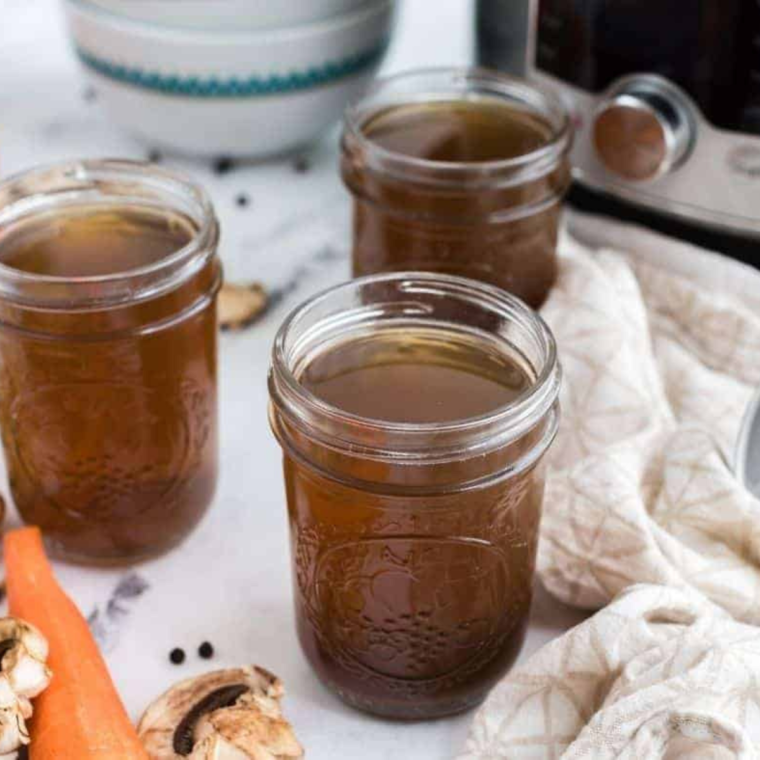
By harnessing the power of your Instant Pot, you can create a rich and nutritious vegetable broth that elevates your culinary creations and promotes sustainability in your kitchen.
So, join us on this journey to transform kitchen scraps into liquid gold and elevate your cooking to new heights!
The Best Homemade Vegetable Broth Recipe
If you have been using your Instant Pot a lot, you will notice that vegetable broth is one of the most used ingredients after water. It helps the Instant Pot bring the dish to pressure, which allows it to cook perfectly.
So, today, I will show you How To Make Vegetable Broth In The Instant Pot, but you can also make the same recipe in your slow cooker or a large saucepan.
I use this recipe a lot in a lot of my recipes, such as INSTANT POT CORN CHOWDER, INSTANT POT VEGETARIAN CHINESE FRIED RICE, and INSTANT POT, EASY NEW ENGLAND CLAM CHOWDER.

Why You Will Love Making Homemade Vegetable Stock In Pressure Cook
Here are some compelling reasons why you’ll love making homemade vegetable stock in a pressure cooker:
- Flavorful Base: Homemade vegetable stock is packed with natural flavors that enhance your dishes’ taste. It’s a versatile and savory base for various recipes, from soups and sauces to risottos and gravies.
- Reduced Food Waste: Making vegetable stock from kitchen scraps helps reduce food waste. You can put those peels, ends, and leftover veggies to good use instead of tossing them in the trash.
- Cost-Efficient: Producing your vegetable stock is cost-effective. Instead of buying store-bought broth or stock, you can create a high-quality broth from items you might otherwise discard.
- Customizable: You have complete control over the ingredients, allowing you to customize the flavor to your liking. Adjust the seasonings, herbs, and vegetables to create a broth that suits your recipes and dietary preferences.
- Nutrient-Rich: Homemade vegetable stock retains more nutrients than store-bought options, which often contain preservatives and high sodium levels. You know exactly what goes into your stock, ensuring it’s healthy and natural.
- Freezer-Friendly: Make a large batch and freeze it in convenient portions. This way, you’ll always have homemade stock for your cooking needs.
- Environmental Impact: By reducing the need for store-bought packaging and processed products, making your vegetable stock is environmentally friendly. It’s a small step towards a more sustainable kitchen.
- Freshness: Your homemade vegetable stock is fresh, without additives or artificial flavors. It’s as close to nature as you can get, enhancing the overall quality of your dishes.
- Zero-Pressure Cooking: Utilizing a pressure cooker speeds up the process significantly, allowing you to create a flavorful vegetable stock in a fraction of the time it would take through traditional simmering methods.
- Satisfaction: There’s a sense of satisfaction in making something delicious and valuable from what might otherwise be food scraps. It’s a rewarding and eco-conscious culinary endeavor.
Making homemade vegetable stock in a pressure cooker elevates your cooking and aligns with eco-friendly and sustainable practices. It’s a win-win for your taste buds and the environment, making it a kitchen essential you’ll love to create time and time again.
Ingredients Needed For Instant Pot Vegetable Broth
Creating a flavorful and versatile vegetable broth requires simple ingredients that you might already have in your kitchen. Here’s what you need:

Remember the step-by-step directions and detailed ingredient list are below, in the printable recipe card at the bottom of the post, as well as the nutritional information.
- Assorted Vegetable Scraps: Collect vegetable scraps like carrot peels, onion ends, celery leaves, and other clean and edible kitchen scraps. These will form the base of your broth, reducing food waste.
- Onions: Use whole or halved onions with the skin on for added flavor and color. The skin imparts a beautiful golden hue to the broth.
- Carrots: Roughly chop or use carrot ends and peelings for a subtle sweetness and depth of flavor.
- Celery: Include celery stalks or their ends to give the broth a mild earthiness and aromatic quality.
- Garlic: Use whole or smashed garlic cloves; a little garlic gives a hint of savory depth and aroma.
- Fresh Herbs: Add fresh herbs like parsley, fresh thyme, rosemary, and bay leaves for fragrance and flavor.
- Peppercorns: A handful of whole peppercorns contributes a gentle spiciness to the broth.
- Salt: A pinch of salt enhances the overall flavor and helps extract the essence of the ingredients.
- Water: Pure, clean water is the primary liquid base for the broth, allowing all the ingredients to meld together.
- Optional Vegetables: Depending on your preference and your scraps, you can also include items like mushrooms, bay leaf, bell peppers, leeks, or tomatoes for additional flavor complexity.
Creating vegetable broth from these ingredients results in a delicious and customizable base for your recipes and promotes sustainability by reducing kitchen waste. Gather your scraps, and start making this flavorful and eco-conscious broth in your Instant Pot!
How To Make Vegetable Broth Instant Pot
Making your own vegetable broth has never been easier; it might just be one of your favorite things in the pressure cooker.
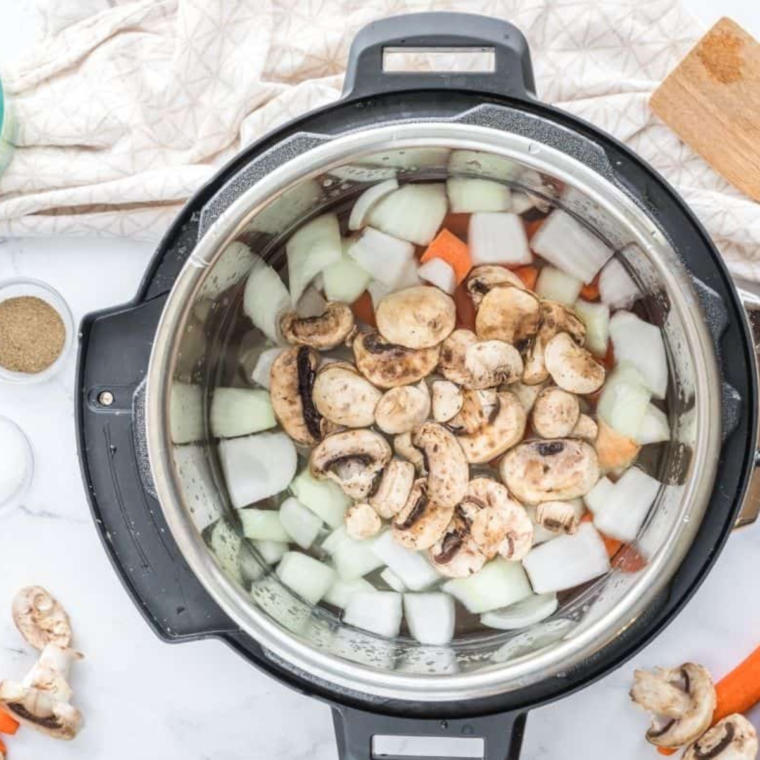
Collect Vegetable Scraps: As you prepare meals throughout the week, collect clean and edible kitchen scraps like carrot peelings, onion ends, and celery leaves. Store them in an airtight container in the freezer until you have enough for a batch of broth.
Prepare the Instant Pot: Start by turning on your Instant Pot and selecting the “Sauté” function. Allow it to heat up.

Add Scraps and Vegetables: Once the Instant Pot is hot, add your collected vegetable scraps, whole onions (with skin), chopped carrots, celery, garlic, and any optional vegetables you want to include. These will form the base of your broth.
Toss in Herbs and Spices: Add a generous handful of fresh herbs, peppercorns, and a pinch of salt to the pot. These ingredients will infuse the broth with aromatic flavors.
Pour in Water: Cover the vegetables and herbs with cold water. Ensure the water level covers all the ingredients, but leave some space at the top of the Instant Pot to prevent overflow.

Pressure Cook: Secure the Instant Pot lid, set the valve to the sealing position, and select the “Pressure Cook” or “Manual” mode. Adjust the cooking time to 30 minutes on high pressure.
Natural Release: Once the pressure cooking cycle is complete, allow the Instant Pot to perform a natural pressure release for 10-15 minutes. Carefully turn the valve to the venting position to release any remaining pressure.
Strain the Broth: Using a fine mesh strainer or cheesecloth, strain the liquid from the solids, capturing the flavorful broth in a large bowl or container. Discard the vegetable solids.
Cool and Store: Allow the vegetable broth to cool to room temperature. Once cooled, you can refrigerate it for immediate use, portion it into airtight containers, and freeze it for later use.
Use as a Base: Your homemade vegetable broth is now ready to use as a base for soups, stews, sauces, and more. Enjoy the rich, natural flavors and the satisfaction of reducing kitchen waste.
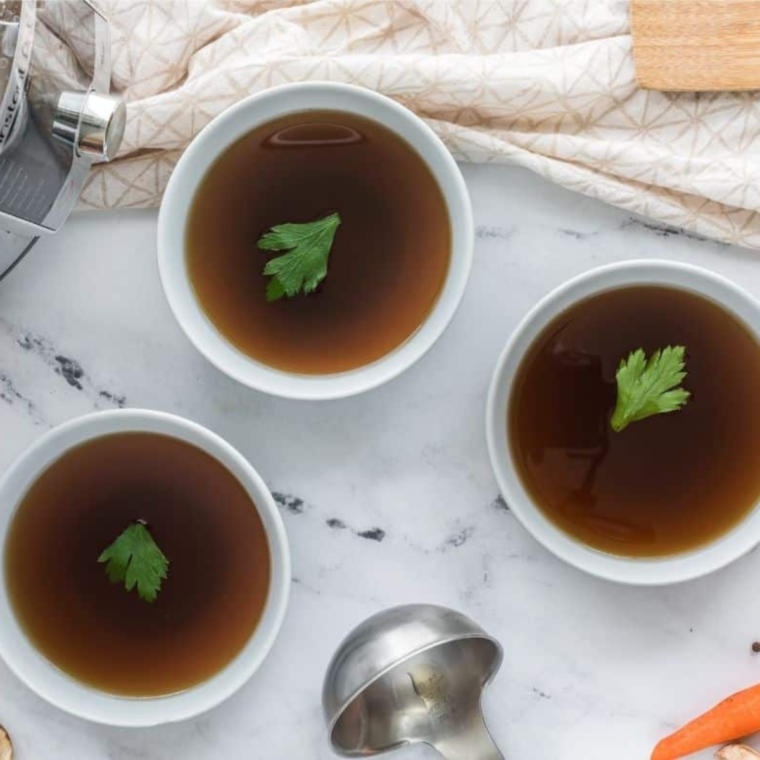
Pro Tips For Instant Pot Vegetable Stock Recipe
Achieving the best results when making Instant Pot Vegetable Broth involves a few pro tips to enhance flavor and efficiency:
- Quality Scraps: Use high-quality, fresh vegetable scraps. Scraps from organic vegetables can yield a cleaner and more flavorful broth.
- Balance Your Scraps: Use various vegetable scraps to create a well-balanced broth. For complexity, include a mix of roots (carrots, onions), aromatics (celery, garlic), and optional vegetables.
- Skin-On Onions: Keep the skin on whole onions. It adds color and enhances the broth’s depth of flavor.
- Avoid cruciferous veggies: Avoid using strong-flavored vegetables like broccoli, cabbage, or Brussels sprouts scraps, as they can overpower the broth with a bitter taste.
- Use Fresh Herbs Sparingly: While fresh herbs are essential for flavor, use them sparingly. A small handful is sufficient, as their flavors can quickly become overwhelming.
- Don’t Overfill: Avoid overfilling the Instant Pot. Leave some space between the ingredients and the maximum fill line to prevent overflow during cooking.
- Adjust Salt Carefully: Be cautious with salt. You can always add more salt later when using the broth in recipes, but correcting an overly salty broth is challenging.
- Natural Pressure Release: Allowing for a natural pressure release for a portion of the cooking time helps extract more flavors from the ingredients. This results in a richer broth.
- Relaxed Gradually: After straining, cool the broth gradually to room temperature before refrigerating or freezing. Rapid cooling can affect the flavor.
- Portion for Convenience: Freeze the broth in small portions, such as ice cube trays or small containers. This makes it easy to defrost only what you need for recipes.
- Label and Date: Label your containers with the date of preparation to help you keep track of freshness. Homemade broth typically stays good in the freezer for up to 6 months.
- Customize to Taste: Adjust the ingredients and seasonings to your taste preferences. Experiment with different herbs and spices to create a unique broth profile.
Following these pro tips ensures your Instant Pot Vegetable Broth turns out flavorful, versatile, and perfect for various culinary applications. Enjoy the satisfaction of creating a sustainable and delicious base for your recipes!
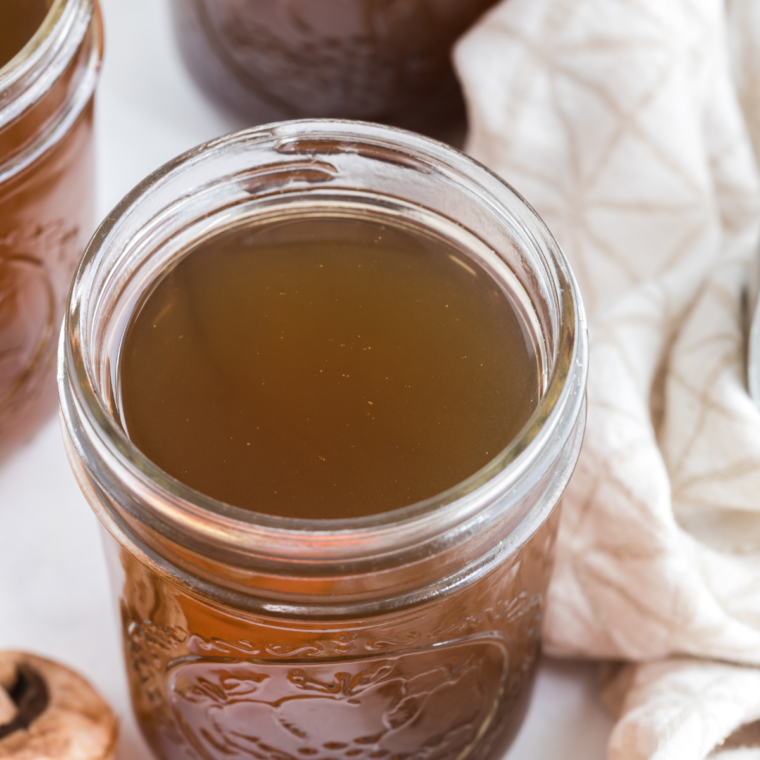
What Are The Best Leftover Veggie Scraps For Instant Pot Veggie Broth
The best leftover veggie scraps for making flavorful Instant Pot veggie broth impart a balanced and rich flavor profile. Here are some of the best leftover veggie scraps to use:
- Carrot Peelings: Carrot peelings, carrot tops, or ends add a mild sweetness and earthy flavor to the broth.
- Onion Ends and Skins: Onion ends, and the onion skins can provide a robust, savory, and slightly sweet base for the broth.
- Celery Leaves and Ends: Celery leaves and the ends of celery stalks contribute a refreshing, herbaceous note to the broth.
- Garlic Cloves or Skins: Whole garlic cloves or garlic skins offer a pleasant flavor and aroma.
- Potato Peels: Potato peels can add a subtle starchy thickness to the broth.
- Mushroom Stems: The stems of mushrooms, especially shiitake or cremini, infuse an earthy and umami-rich quality.
- Leek Greens: Leek greens, which are often discarded, provide a gentle onion-like flavor.
- Bell Pepper Cores: The cores of bell peppers, including the seeds, can add a hint of sweetness and mild pepper flavor.
- Tomato Scraps: Tomato scraps, like the cores or ends, offer a slightly acidic and tomatoey essence.
- Herb Stems: Stems from fresh herbs like parsley, thyme, rosemary, and cilantro can enhance the aromatic profile of the broth.
- Optional Veggies: Depending on your taste preferences, you can also include optional vegetables like tomatoes, mushrooms, or bell peppers for added complexity.

Faq’s:
How to store homemade instant pot vegetable broth: Allow the vegetable broth to cool to room temperature before storing it. Rapid cooling can affect the flavor and texture. Decide how you want to portion the broth for future use. Common options include small containers, ice cube trays, mason jars, or silicone molds. If you’re not planning to use the broth within a few days, place it in the freezer. Vegetable broth can typically be stored in the freezer for up to 6 month
Can I use vegetable scraps that have been in the freezer for a while? Yes, you can use frozen vegetable scraps as long as they have been stored properly. Adequately sealed and frozen scraps can retain their flavor for several months.
Is it necessary to use whole onions with the skin on? While using whole onions with the skin on can enhance the color and flavor of the broth, you can also use onion scraps or peeled onions if that’s what you have available.
Can I add salt to the broth before pressure cooking? It’s generally recommended to avoid adding salt before pressure cooking. You can always season the broth with salt when you use it in specific recipes.
Can I reuse vegetable scraps for a second batch of broth? It’s best to use fresh scraps for each batch to ensure the most flavorful broth. Reusing scraps may result in a weaker-tasting veggie stock.
What’s the difference between a natural and quick release for pressure cooking? A natural release allows the Instant Pot to depressurize slowly, which can help extract more flavor from the ingredients. A quick release involves manually releasing the pressure immediately after cooking.
Can I add spices like peppercorns or bay leaves for extra flavor? Absolutely! Adding spices like peppercorns, bay leaves, or other favorite herbs and spices can enhance the flavor profile of your vegetable broth. Experiment to find your preferred blend.
Is there a specific vegetable I should avoid using in the broth? While most vegetables are suitable for vegetable broth, it’s best to avoid vegetables with strong, overpowering flavors like turnips, radishes, or excessively bitter greens.
Can I use this vegetable broth in recipes as a substitute for chicken or beef broth? Yes, you can use homemade vegetable broth as a substitute for chicken or beef broth in recipes. It works well in vegetarian or vegan dishes and adds depth to a variety of recipes.
Can I pressure cook the broth for a shorter time to save time? While you can adjust the cooking time, a longer one typically results in a richer and more flavorful broth. A 30-minute pressure cooking cycle allows for better flavor extraction.
How do I defrost frozen vegetable broth? You can defrost frozen vegetable broth by placing it in the refrigerator overnight or gently heating it on the stove or microwave. Be sure to stir it occasionally if you choose the stovetop or microwave method.
More Instant Pot Recipes
- INSTANT POT BROCCOLI AND CHEDDAR CHEESE SOUP
- NINJA FOODI SOUTHWESTERN CHILI
- INSTANT POT SAUSAGE AND LENTIL SOUP
- INSTANT POT COPYCAT NORDSTROM’S TOMATO BASIL SOUP
- INSTANT POT CORN CHOWDER
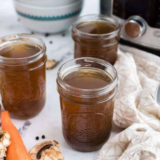
Instant Pot Vegetable Broth
Description
Ingredients
- large onion, peeled and cut up in large chunks
- 3 stalks carrots, peeled and diced
- 1 cup mushrooms
- 4 stalks celery, peeled and diced
- 10 cups water
- 2 teaspoons salt
- 2 teaspoons pepper
Instructions
- Collect Vegetable Scraps: As you prepare meals throughout the week, collect clean and edible kitchen scraps like carrot peelings, onion ends, and celery leaves. Store them in an airtight container in the freezer until you have enough for a batch of broth.
- Prepare the Instant Pot: Start by turning on your Instant Pot and selecting the “Sauté” function. Allow it to heat up.
- Add Scraps and Vegetables: Once the Instant Pot is hot, add your collected vegetable scraps, whole onions (with skin), chopped carrots, celery, garlic, and any optional vegetables you want to include. These will form the base of your broth.
- Toss in Herbs and Spices: Add a generous handful of fresh herbs, peppercorns, and a pinch of salt to the pot. These ingredients will infuse the broth with aromatic flavors.
- Pour in Water: Cover the vegetables and herbs with cold water. Ensure the water level covers all the ingredients, but leave some space at the top of the Instant Pot to prevent overflow.
- Pressure Cook: Secure the Instant Pot lid, set the valve to the sealing position, and select the “Pressure Cook” or “Manual” mode. Adjust the cooking time to 30 minutes on high pressure.
- Natural Release: Once the pressure cooking cycle is complete, allow the Instant Pot to perform a natural pressure release for 10-15 minutes. Carefully turn the valve to the venting position to release any remaining pressure.
- Strain the Broth: Using a fine mesh strainer or cheesecloth, strain the liquid from the solids, capturing the flavorful broth in a large bowl or container. Discard the vegetable solids.
- Cool and Store: Allow the vegetable broth to cool to room temperature. Once cooled, you can refrigerate it for immediate use, portion it into airtight containers, and freeze it for later use.
- Use as a Base: Your homemade vegetable broth is now ready to use as a base for soups, stews, sauces, and more. Enjoy the rich, natural flavors and the satisfaction of reducing kitchen waste.
Equipment
- Instant Pot Pressure Cooker, or Ninja Foodi Pressure Cooker
Nutrition
Share this recipe
We can’t wait to see what you’ve made! Mention @forktospoon or tag #forktospoon!

